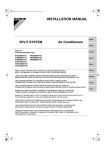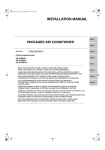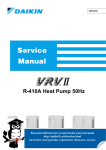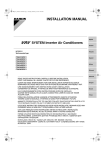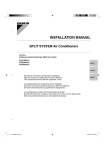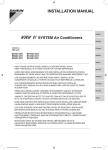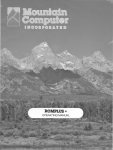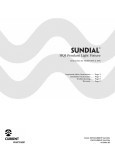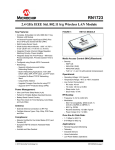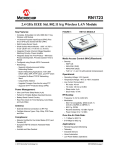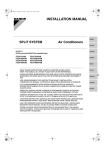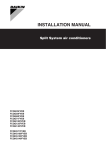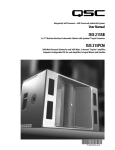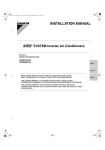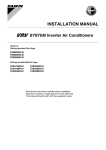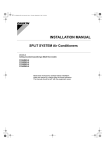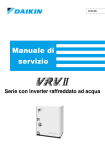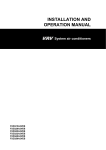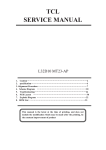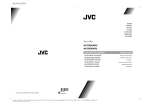Download FXZQ 20-50 M INSTALLATION
Transcript
,167$//$7,210$18$/
6<67(0,QYHUWHU$LU&RQGLWLRQHUV
(QJOLVK
'HXWVFK
02'(/6
&HLOLQJPRXQWHG0XOWLIORZFDVVHWWHW\SH
);=409(
);=409(
);=409(
);=409(
);=409(
5($'7+(6(,16758&7,216&$5()8//<%()25(,167$//$7,21
.((37+,60$18$/,1$+$1'<3/$&()25)8785(5()(5(1&(
/(6(16,(',(6($1:(,681*(1925'(5,167$//$7,21625*)b/7,*'85&+
%(:$+5(16,(',(6($1/(,781*)h563b7(5(%(=8*1$+0(*5,))%(5(,7$8)
)UDQoDLV
(VSDxRO
,WDOLDQR
1HGHUODQGV
/,5(62,*1(86(0(17&(6,16758&7,216$9$17/¶,167$//$7,21
&216(59(5&(0$18(/$3257(('(0$,132855()(5(1&(8/7(5,(85(
/($&8,'$'26$0(17((67$6,16758&&,21(6$17(6'(,167$/$5
*8$5'((67(0$18$/(181/8*$5$0$123$5$/((5(1&$62'(7(1(5
$/*81$'8'$
35,0$'(//¶,167$//$=,21(/(**(5($77(17$0(17(48(67(,6758=,21,
7(1(5(48(6720$18$/($3257$7$',0$123(55,)(5,0(17,)8785,
.
/((6'(=(,16758&7,(6=25*98/',*'2259225,167$//$7,(%(:$$5'(=(+$1
'/(,1',1*:$$58+(0.8177(58*9,1'(19225/$7(5(1$6/$*
/(,$&20$7(1d2(67$6,16758d®(6$17(6'(5($/,=$5$,167$/$d2
0$17(1+$(67(0$18$/$26(8$/&$1&(3$5$)8785$6&2168/7$6
ПЕРЕД НАЧАЛОМ МОНТАЖА ВНИМАТЕЛЬНО ОЗНАКОМЬТЕСЬ С ДАННЫМИ
ИНСТРУКЦИЯМИ. СОХРАНИТЕ ДАННОЕ РУКОВОДСТВО В МЕСТЕ, УДОБНОМ ДЛЯ
ОБРАЩЕНИЯ В БУДУЩЕМ.
3RUWXJXHV
Russian
3*
(0$
)6
FXZQ20MVE
FXZQ25MVE
FXZQ32MVE
FXZQ40MVE
FXZQ50MVE
VRV SYSTEM Inverter Air Conditioners
Installation manual
CONTENTS
1.
2.
3.
4.
5.
6.
7.
8.
9.
10.
11.
12.
SAFETY CONSIDERATIONS .................................................................................... 1
BEFORE INSTALLATION .......................................................................................... 2
SELECTING INSTALLATION SITE ........................................................................... 4
PREPARATIONS BEFORE INSTALLATION ............................................................. 6
INDOOR UNIT INSTALLATION ................................................................................. 7
REFRIGERANT PIPING WORK ................................................................................ 8
DRAIN PIPING WORK ............................................................................................. 10
ELECTRIC WIRING WORK ..................................................................................... 13
WIRING EXAMPLE AND HOW TO SET THE REMOTE CONTROLLER ............... 14
FIELD SETTINGS .................................................................................................... 18
INSTALLATION OF THE DECORATION PANEL .................................................... 20
TEST OPERATION .................................................................................................. 20
1. SAFETY CONSIDERATIONS
Please read these “SAFETY CONSIDERATIONS” carefully before installing air conditioning equipment and
be sure to install it correctly. After completing the installation, make sure that the unit operates properly during the start-up operation. Please instruct the customer on how to operate the unit and keep it maintained.
Also, inform customers that they should store this installation manual along with the operation manual for
future reference.
This air conditioner comes under the term “appliances not accesible to the general public”.
Meaning of warning and caution symbols
WARNING ..........Failure to observe a warning may result in death.
CAUTION ...........Failure to observe a caution may result in injury or damage to the equipment.
•
•
•
•
•
•
•
WARNING
Ask your dealer or qualified personnel to carry out installation work. Do not try to install the machine yourself.
Improper installation may result in water leakage, electric shocks or fire.
Perform installation work in accordance with this installation manual.
Improper installation may result in water leakage, electric shocks or fire.
When installing the unit in a small room, take measures against to keep refrigerant concentration from
exceeding allowable safety limits in the event of refrigerant leakage. Contact the place of purchase for
more information. Excessive refrigerant in a closed ambient can lead to oxygen deficiency.
Be sure to use only the specified accessories and parts for installation work.
Failure to use the specified parts may result in water leakage, electric shocks, fire or the unit falling.
Install the air conditioner on a foundation strong enough to withstand the weight of the unit.
A foundation of insufficient strength may result in the equipment falling and causing injuries.
Carry out the specified installation work after taking into account strong winds, typhoons or earthquakes.
Improper installation work may result in the equipment falling and accidents.
Make sure that a separate power supply circuit is provided for this unit and that all electrical work is carried out by qualified personnel according to local laws and regulations and this installation manual.
An insufficient power supply capacity or improper electrical construction may lead to electric shocks or
fire.
English
1
• Make sure that all wiring is secured, the specified wires are used, and no external forces act on the terminal connections or wires.
Improper connections or installation may result in fire.
• When wiring the power supply and connecting the remote controller wiring and transmission wiring, position the wires so that the control box lid can be securely fastened.
Improper positioning of the control box lid may result in electric shocks, fire or the terminals overheating.
• If the refrigerant gas leaks during installation, ventilate the area immediately.
Toxic gas may be produced if the refrigerant gas comes into contact with fire.
• After completing the installation work, check that the refrigerant gas does not leak.
Toxic gas may be produced if the refrigerant gas leaks into the room and comes into contact with a source
of fire, such as a fan heater, stove or cooker.
• Before touching electrical parts, turn off the unit.
CAUTION
• Ground the air conditioner.
• Do not connect the ground wire to gas or water pipes, lightning rods or telephone ground wires. Incomplete grounding may result in electric shocks.
• Be sure to install an earth leakage breaker.
Failure to install an earth leakage breaker may result in electric shocks.
• While following the instructions in this installation manual, install drain piping in order to ensure proper
drainage and insulate piping in order to prevent condensation.
Improper drain piping may result in water leakage and property damage.
• Install the indoor and outdoor units, power cord and connecting wires at least 1 meter away from televisions or radios in order to prevent image interference or noise.
(Depending on the radio waves, a distance of 1 meter may not be sufficient enough to eliminate the
noise.)
• Remote controller (wireless kit) transmitting distance can result shorter than expected in rooms with electronic fluorescent lamps. (inverter or rapid start types)
Install the indoor unit as far away from fluorescent lamps as possible.
• Do not install the air conditioner in the following locations:
(a) where a mineral oil mist or an oil spray or vapor is produced, for example in a kitchen
Plastic parts may deteriorate and fall off or result in water leakage.
(b) where corrosive gas, such as sulfurous acid gas, is produced
Corroding copper pipes or soldered parts may result in refrigerant leakage.
(c) near machinery emitting electromagnetic waves
Electromagnetic waves may disturb the operation of the control system and result in a
malfunction of the equipment.
(d) where flammable gases may leak, where there are carbon fiber or ignitable dust suspensions in the
air, or where volatile flammables such as thinner or gasoline are handled.
Operating the unit in such conditions may result in fire.
2. BEFORE INSTALLATION
• When moving the unit while removing it from the carton box, be sure to lift it by holding on to the
four lifting lugs without exerting any pressure on other parts, especially, the refrigerant piping,
drain piping, and other resin parts.
• Be sure to check the type of R410A refrigerant to be used before installing the unit.(Using an incorrect
refrigerant will prevent normal operation of the unit.)
• The accessories needed for installation must be retained in your custody until the installation work is completed. Do not discard them!
• Decide upon a line of transport.
• Leave the unit inside its packaging while moving, until reaching the installation site. Where unpacking is
unavoidable, use a sling of soft material or protective plates together with a rope when lifting, to avoid
damage or scratches to the unit.
• Especially, do not unfasten packing case(top) guarding the control box until suspending the unit.
• When selecting installation site, refer to the paper pattern.
• For the installation of an outdoor unit, refer to the installation manual attached to the outdoor unit.
2
English
• Do not install or operate the unit in rooms mentioned below.
• Laden with mineral oil, or filled with oil vapor or spray like in kitchens. (Plastic parts may deteriorate.)
• Where corrosive gas like sulfurous gas exists. (Copper tubing and brazed spots may corrode.)
• Where volatile flammable gas like thinner or gasoline is used.
• Where machines can generate electromagnetic waves. (Control system may malfunction.)
• Where the air contains high levels of salt such as that near the ocean and where voltage fluctuates
greatly such as that in factories. Also in vehicles or vessels.
• This unit, both indoor and outdoor, is suitable for installation in a commercial and light industrial
environment. If installed as a household appliance it could cause electromagnetic interference.
2-1
ACCESSORIES
Check the following accessories are included with your unit.
Name
(1)Drain hose
(2)Clamp
(3)Washer for
hanging bracket
Quantity
1 pc.
1 pc.
8 pcs.
(4)Clamp
(Big)
6 pcs.
(Small)
1 pc.
(5)Paper pattern
for installation
1 pc.
Also used as
packing material
Shape
Name
(6)Screws
(M5)
Quantity
4 pcs.
(7)Washer
Insulation for fitting
fixing plate
4 pcs.
1 each.
(8)For gas pipe
For paper pattern
for installation
Sealing pad
1 each.
(12)Sealing
material
2 pcs.
(10)Large
Operation
manual
Installation
manual
Shape
(9)For liquid pipe
2-2
(Other)
(11)Small
OPTIONAL ACCESSORIES
• The optional decoration panel and remote controller are required for this indoor unit. (Refer to Table 1, 2)
Table 1
Unit model
FXZQ20·25·32·40·50MVE
Optional decoration panel
BYFQ60BW1
Colour : White
• These are two types of remote controllers: wired and wireless. Select a remote controller from Table 2
according to customer request and install in an appropriate place.
Table 2
Remote controller type
Wired type
Wireless type
European market
Cooling only type Heat Pump type
BRC1C517
BRC7E531W
BRC7E530W
Australian market
Cooling only type Heat Pump type
BRC1A61
BRC7E531W
BRC7E530W
NOTE
• If you wish to use a remote controller that is not listed in Table 2, select a suitable remote controller after
consulting catalogs and technical materials.
English
3
FOR THE FOLLOWING ITEMS, TAKE SPECIAL CARE DURING CONSTRUCTION AND
CHECK AFTER INSTALLATION IS FINISHED.
a. Items to be checked after completion of work
Items to be checked
Are the indoor and outdoor unit fixed firmly?
Is the gas leak test finished?
Is the unit fully insulated?
Dose drainage flow smoothly?
Dose the power supply voltage correspond
to that shown on the name plate?
Are wiring and piping correct?
Is the unit safely grounded?
Is wiring size according to specifications?
Is something blocking the air outlet or inlet
of either the indoor or outdoor units?
Are refrigerant piping length and additional
refrigerant charge noted down?
If not properly done, what is likely to occur
The units may drop, vibrate or make noise.
It may result in insuffcient cooling.
Condensate water may drip.
Condensate water may drip.
The unit may malfunction or the components burn out.
The unit may malfunction or the components burn out.
Dangerous at electric leakage.
The unit may malfunction or the components burn out.
Check
It may result in insufficient cooling.
The refrigerant charge in the system is not
clear.
b. Items to be checked at time of delivery
Also review the “SAFETY CONSIDERATIONS”
Items to be checked
Did you explain about operations while showing the instruction manual to your customer?
Did you hand the instruction manual over to your customer?
Check
c. Points for explanation about operations
The items with
WARNING and
CAUTION marks in the instruction manual are the items pertaining
to possibillties for bodily injury and material damage in addition to the general usage of
the product. Accordingly, it is necessary that you make a full explanation about the described contents
and also ask your customers to read the instruction manual.
2-3
NOTE TO THE INSTALLER
Be sure to instruct customers how to properly operate the unit (especially cleaning filters, operating different functions, and adjusting the temperature) by having them carry out operations themselves while looking at the manual.
3. SELECTING INSTALLATION SITE
Please attach additional thermal insulation material to the unit body when it is believed that the relative
humidity in the ceiling exceeds 80%. Use glass wool, polyethylene foam, or similar with a thickness of 10
mm or more as thermal insulation material.
For this unit, you are able to select air flow direction.
To enable the discharge of air in 2 or 3 directions, it is necessary to purchase the sealing member of air discharge outlet.
(1) Select an installation site where the following conditions are fulfilled and that meets your customer’s approval.
• In the upper space (including the back of the ceiling) of the indoor unit where there is no possible dripping of water from the refrigerant pipe, drain pipe, water pipe, etc.
4
English
•
•
•
•
•
•
•
•
Where optimum air distribution can be ensured.
Where nothing blocks air passage.
Where condensate can be properly drained.
Where the ceiling is strong enough to bear the indoor unit weight.
Where the false ceiling is not noticeably on an incline.
Where sufficient clearance for maintenance and service can be ensured.
Where there is no risk of flammable gas leakage.
Where piping between indoor and outdoor units is possible within the allowable limit.
(Refer to the installation manual for the outdoor unit.)
[Space required for installation] (mm)
>
>
* 1500
Air
outlet
* 1500
1500
2500
>
>
>
For installation
in high places
H
* 1500
Air
Air outlet
inlet
>
* 1500
>
>
* 1500
Fig. 1
* 1500
Fig. 2
NOTE
• Leave 200 mm or more space where marked with the *, on sides where the air outlet is closed.
Model
FXZQ20·25·32·40·50
H
285 (Confirm the space of 295 or more)
CAUTION
• Any vents, light fixtures, or other appliances which may disturb the airflow might cause the top side to
become dirty if located too nearby, so follow the figure below when installing.
• Install the indoor and outdoor units, power cord and connecting wires at least 1 meter away from televisions or radios in order to prevent image interference or noise.
(Depending on the radio waves, a distance of 1 meter may not be sufficient enough to eliminate the
noise.)
(2) Ceiling height
• Install this unit where the height of bottom panel is more than 2.5 m so that the user cannot easily
touch.
(3) Air flow direction
Select the air flow directions best suited to the room and point of installation. (For air outlet in 2 or 3
directions, it is necessary to make field settings by remote controller and to close the air outlet(s).
Refer to the installation manual of the sealing member of air discharge outlet and the section entitled 10.
FIELD SETTINGS)
[Air flow direction] (Example)
Piping
Air outlet in 4 directions
Piping
Air outlet in 3 directions
Piping
Air outlet in 2 directions
(4) Use suspension bolts for installation. Check whether the ceiling is strong enough to support the
weight of the unit or not. If there is a risk, reinforce the ceiling before installing the unit.
(Installation pitch is maked on the paper pattern for installation. Refer to it to check for points requiring
reinforcing.)
English
5
4. PREPARATIONS BEFORE INSTALLATION
(1) Relation of ceiling opening to unit and suspension bolt position.
Suspension
bolt (×4)
533 (Suspension bolt pitch)
575 (indoor unit)
585-660 (Ceiling opening)
700 (Decoration panel)
(Ceiling opening dimension)
585 – *660
Hanger
bracket
False
ceiling
20 ≤
20 ≤
(Ceiling-panel overlapping dimension)
View as seen from A
Fig. 3
Fig. 4
(180)
700 (Decoration panel)
585-660 (Ceiling opening)
575 (indoor unit)
533(Suspension bolt pitch)
Refrigerant
piping
(mm)
A
NOTE
• Installation is possible with a ceiling dimension of 660 mm (marked with *). However, to achieve a ceilingpanel overlapping dimension of 20 mm, the spacing between the ceiling and the unit should be 45 mm or
less. If the spacing between ceiling and the unit is over 45 mm, attach ceiling material to
part or recover
the ceiling.
False
ceiling
False
ceiling
Ceiling material
< 45
< 45
(mm)
Fig. 5
(2) Make the ceiling opening needed for installation where applicable. (For existing ceilings)
• Refer to the paper pattern for installation (5) for ceiling opening dimensions.
• Create the ceiling opening required for installation. From the side of the opening to the casing outlet,implement the refrigerant and drain piping and wiring for remote controller (unnecessary for wireless type) and wiring between units. Refer to each PIPING or WIRING section.
• After making an opening in the ceiling, it may be necessary to reinforce ceiling beams to keep the ceiling level and to prevent it from vibrating. Consult the builder for details.
(3) Install the suspension bolts.
<installation example>
(Use either a M8 ~ M10 size bolt) Use a hole-in
anchor for existing ceilings, and a sunken insert,
Ceiling slab
sunken anchor or other field supplied parts for new
Anchor
ceilings to reinforce the ceiling to bear the weight of
Long nut or turn-buckle
the unit.
Suspension bolt
Adjust clearance (50 – 100 mm) from the ceiling
before proceeding further.
False ceiling (mm)
NOTE
• All the above parts are field supplied.
6
Fig. 6
English
5. INDOOR UNIT INSTALLATION
Installing optional accessories (except for the decoration panel) before installing the indoor unit is
easier. However, for existing ceilings, install fresh air intake kit and branch duct before installing the
unit.
As for the parts to be used for installation work, be sure to use the provided accessories and specified parts
designated by our company.
(1) For new ceilings
(1-1) Install the indoor unit temporarily.
• Attach the hanger bracket to the suspension bolt. Be sure to fix it securely by using a nut and
washer (3) from the upper and lower sides of the hanger bracket.
The washer fixing plate (7) will prevent the washer from falling.
Nut (Field supplied)
Washer (3) (attached)
Insert
Hanger bracket
Washer fixing plate (7)
(attached)
Tighten
(double nut)
[Securing the washer]
[Securing the hanger bracket]
Fig. 7
Fig. 8
(1-2) Refer to the paper pattern for installation (5) for ceilling opening dimension.
Consult the builder or carpenter for details.
• The center of the ceiling opening is indicated on the paper pattern for installation.
The center of the unit is indicated on the paper pattern for installation.
• Fix the paper pattern to the unit with screws (6) (×4).
Paper pattern for installation (5)
(attached)
Screws (6)
(attached)
Screws (6)
(attached) [Installation of paper pattern for installation]
Fig. 9
<Ceiling work>
(1-3) Adjust the unit to the right position for installation.
(Refer to 4.PREPARATIONS BEFORE INSTALLATION-(1))
(1-4) Check the unit is horizontally level.
CAUTION
• The indoor unit is equipped with a built-in drain
pump and float switch. Verify that it is level by using
a water level or a waterfilled vinyl tube.
(If the unit is tilted against condensate flow, the float
switch may malfunction and cause water to drip.)
(1-5) Remove the washer fixing plate (7) used for preventing the
washer from falling and tighten the upper nut.
(1-6) Remove the paper pattern for installation (5).
English
Water level
Vinyl tube
[Maintaining horizontality]
Fig. 10
7
(2) For existing ceilings
(2-1) Install the indoor unit temporarily.
• Attach the hanger bracket to the suspension bolt. Be sure to fix it securely by using a nut and
washer (3) from the upper and lower sides of the hanger bracket.
The washer fixing plate (7) will prevent the washer from falling.
Nut (Field supplied)
Washer (3) (attached)
Insert
Hanger bracket
Tighten
(double nut)
Washer fixing plate (7)
(attached)
[Securing the washer]
[Securing the hanger bracket]
Fig. 11
(2-2) Adjust the height and position of the unit.
(Refer to 4.PREPARATIONS BEFORE INSTALLATION-(1).)
(2-3) Perform steps (1-4), (1-5) in (1) For new ceilings.
Fig. 12
6. REFRIGERANT PIPING WORK
<For refrigerant piping of outdoor units, see the installation manual attached to the outdoor unit.>
<Execute heat insulation work completely on both sides of the gas piping and the liquid piping.
Otherwise, a water leakage can result sometimes.>
(When using a heat pump, the temperature of the gas piping can reach up to approximately 120°C, so use
insulation which is sufficiently resistant.)
<Also, in cases where the temperature and humidity of the refrigerant piping sections might exceed
30°C or RH80%, reinforce the refrigerant insulation. (20 mm or thicker) Condensation may form on
the surface of the insulating material.>
<Before refrigerant piping work, check which type of refrigerant is used. Proper operation is not possible if the types of refrigerant are not the same.>
CAUTION
• Use a pipe cutter and flare suitable for the type of refrigerant.
• Apply ester oil or ether oil around the flare portions before connectiong.
• To prevent dust, moisuture or other foreign matter from infiltrating the tube, either pinch the end
or cover it with tape.
• Do not allow anything other than the designated refrigerant to get mixed into the refrigerant circuit, such as air, etc. If any refrigerant gas leaks while working on the unit, ventilate the room
thoroughly right away.
8
English
• The outdoor unit is charged with refrigerant.
• Be sure to use both a spanner and torque wrench together, as shown in
the drawing, when connecting or disconnecting pipes to/from the unit.
(Refer to Fig. 13)
• Refer to Table 3 for the dimensions of flare nut spaces.
• When connecting the flare nut, coat the flare section (both inside and
outside) with ester oil or ether oil, rotate three or four times first, then
screw in. (Refer to Fig. 14)
CAUTION
Over-tightening may damage the flare and cause
a refrigerant leakage.
Torque wrench
Spanner
Piping union
Flare nut
Fig. 13
Ester oil or ether oil
NOTE
• Use the flare nut included with the unit main body.
Table 3
Fig. 14
Pipe size
Tightening torque
Flare dimensions
A (mm)
ø6.4(1/4")
14.2 - 17.2 N·m
(144 - 175 kgf·cm)
8.7-9.1
ø12.7(1/2")
49.5 - 60.3 N·m
(505 - 615 kgf·cm)
16.2 - 16.6
Flare
• Refer to “Table 3” to determine the proper tightening torque.
CAUTION
Over-tightening may damage the flare and cause a refrigerant leakage.
Not recommendable but in case of emergency
You must use a torque wrench but if you are obliged to install the unit without a torque wrench, you may follow the installation method mentioned below.
After the work is finished, make sure to check that there is no gas leak.
When you keep on tightening the flare nut with a spanner, there is a point where the tightening torque suddenly increases. From that position, further tighten the flare nut the angle shown below:
Pipe size
ø6.4 (1/4")
ø12.7 (1/2")
Further tightening angle
60 to 90 degrees
30 to 60 degrees
Recommended arm length of tool
Approx. 150mm
Approx. 250mm
CAUTION
CAUTION TO BE TAKEN WHEN BRAZING REFRIGERANT PIPING
Do not use flux when brazing refrigerant piping. Therefore, use the phosphor copper brazing filter metal
(BCuP) which does not require flux.
(Flux has extremely harmful infulence on refrigerant piping sysems. For instance, if the chlorine based
flux is used, it will cause pipe corrosion or, in particular, if the flux contains fluorine, it will damage the
refrigerant oil.)
• Before brazing local refrigerant piping, nitrogen gas shall be blown through the piping to expel air from the
piping.
If your brazing is done without nitrogen gas blowing, a large amount of oxide film develops inside the piping, and could cause system malfunction.
• When brazing the refrigerant piping, only begin brazing after having carried out nitrogen substitution or
while inserting nitrogen into the refrigerant piping. Once this is done, connect the indoor unit with a flared
or a flanged connection.
English
9
• Nitrogen should be set to 0.02 Mpa (0.2 kg/cm2) with a pressure-reducing valve if brazing while inserting
nitrogen into the piping. (Refer to Fig.15)
Taping
Refrigerant piping
Pressure-reducing valve
Part to be
brazed
hands valve
Nitrogen
Nitrogen
Fig. 15
• Make absolutely sure to execute heat insulation works on the pipe-connecting section after checking gas
leakage by thoroughly studying the following figure and using the attached heat insulating materials for fitting (8) and (9). (Fasten both ends with the clamps (4).)
(Refer to Fig. 16)
• Wrap the sealing pad (11) only around the insulation for the joints on the gas piping side.
(Refer to Fig. 16)
Small sealing pad
(attached) (11)
(Wrap the piping union
with the sealing pad.)
Clamp (4)
(Big 4)
Insulation for fitting
(attached) (9)
(for liquid pipe)
(attached)
Liquid piping
Insulation for fitting (attached) (8)
(for gas pipe)
Gas piping
Fig. 16
CAUTION
Be sure to insulate any field piping all the way to the piping connection inside the unit. Any exposed piping
may cause condensation or burns if touched.
7. DRAIN PIPING WORK
(1) Carry out the drain piping
• Lay pipes so as to ensure that drainage can occur with no problems.
• Employ a pipe with either the same diameter or with the diameter larger (excluding the raising section)
than that of the connecting pipe (PVC pipe, nominal diameter 20 mm, outside diameter 26 mm).
• keep the drain pipe short and sloping downwards at a gradient of at least 1/100 to prevent air pockets from
forming.
• If the drain hose cannot be sufficiently set on a slope, refer to PRECAUTIONS FOR DRAIN RAISING PIPING on page 11.
• To keep the drain hose from sagging, space hanger bracket every 1 to 1.5 m.
Hanger bracket
GOOD
Fig. 17
10
1/100
gradient or more
WRONG
WRONG
Fig. 18
English
• Use the attached drain hose (1) and clamp (2).
• Insert the drain hose into the drain socket up to the base, and tighten the clamp securely within the portion
of a gray tape of the hose-inserted tip. Tighten the clamp until the screw head is less than 4 mm from the
hose.
• Wrap the attached large sealing pad (10) over the clamp and drain hose to insulate.
• Make sure that heat insulation work is executed on the following 2 spots to prevent any possible water
leakage due to dew condensation.
• Indoor drain pipe
• Drain socket
Clamp (2)
(attached)
Clamp (2)
(attached)
Large sealing pad (10)
(attached)
Drain hose (1)
(attached)
Tape (Gray)
4mm
Fig. 19
Fig. 20
<PRECAUTIONS FOR DRAIN RAISING PIPING>
• Install the drain raising pipes at a height of less than 545 mm.
• Install the drain raising pipes at a right angle to the indoor unit and no more than 300 mm from the unit.
Hanger bracket
Ceiling slab
Adjustable
( 545)
205
1-1.5m
Clamp (2)
(attached)
750
300
Drain hose (attached)(1)
(mm)
Drain raising pipe
Raising section
Fig. 21
100mm
NOTE
• To ensure no excessive pressure is applied to the included drain hose (1), do not bend or twist when installing. (This may cause leakage.)
• If converging multiple drain pipes, install according to the procedure shown below.
Slope downwards at a
gradient of at least 1/100 to
prevent air pockets from forming
T-joint converging drain pipes
Fig. 22
Select converging drain pipes whose gauge is suitable for the operating capacity of the unit.
(2) After piping work is finished, check if drainage flows smoothly.
• Add approximately 1000 cc of water slowly from the air outlet and check drainage flow.
WHEN ELECTRIC WIRING WORK IS FINISHED
• Check drainage flow during cooling operation.
English
11
WHEN ELECTRIC WIRING WORK IS NOT FINISHED
• Remove the control box lid, connect a power supply (SINGLE PHASE 50Hz 220-240V or 60Hz 220V) to
connections L and N on the power supply terminal block and remote controller to terminal block for remote
controller. When carrying out wiring work around the control box, make sure none of the connectors come
undone. Be sure to attach the control box lid before turning on the power.
Next, press the inspection/test operation button “
” on the remote controller. The unit will engage the
test operation mode. Press the operation mode selector button “
” until selecting FAN OPERATION
“
”. Then, press the ON/OFF button “
”. The indoor unit fan and drain pump will start up. After confirming drainage (Fig. 23, Fig. 24), turn off the power and remove the power supply. Press “
” to go
back to the first mode.
• Note that the fan also starts rotating.
• Attach the control box lid as before.
Drain pipe
Fig. 23
100
(mm)
Plastic container
for pouring
(Tube should be
about 100 mm long.)
Service drain outlet (with rubber plug)
(Use this outlet to drain water from
the drain pan)
<Adding water through air outlet>
[Method of adding water]
REMOTE TRANSMISSION FORCED
CONTROL
WIRING
OFF
REMOTE TRANSMISSION FORCED
CONTROL
WIRING
OFF
Control
box lid
Remote
controller wiring
Terminal block
for remote controller
Remove the control box lid
(take off 2 screws)
L
N
L
N
L
N
Single phase
power supply
50Hz 220-240V
60Hz 220V
(
)
Power supply
terminal block
Fig. 24
12
English
CAUTION
• Drain piping connections
Do not connect the drain piping directly to sewage pipes that smell of ammonia. The ammonia in the sewage might enter the indoor unit through the drain pipes and corrode the heat exchanger.
• Keep in mind that it will become the cause of getting drain pipe blocked if water collects on drain pipe.
8. ELECTRIC WIRING WORK
8-1
•
•
•
•
•
•
•
•
•
•
GENERAL INSTRUCTIONS
All field supplied parts and materials and electric works must conform to local codes.
Use copper wire only.
For electric wiring work, refer to also “Wiring diagram label” attached to the control box lid.
For remote controller wiring details, refer to the installation manual attached to the remote controller.
All wiring must be performed by an authorized electrician.
This system consists of multiple indoor units. Mark each indoor unit as unit A, unit B..., and be sure the
terminal board wiring to the outdoor unit and BS unit are properly matched. If wiring and piping between
the outdoor unit and an indoor unit are mismatched, the system may cause a malfunction.
A circuit breaker capable of shutting down power supply to the entire system must be installed.
Refer to the installation manual attached to the outdoor unit for the size of power supply wiring connected
to the outdoor unit, the capacity of the circuit breaker and switch, and wiring instructions.
Be sure to ground the air conditioner.
Do not connect the ground wire to gas and water pipes, lightning rods, or telephone ground wires.
• Gas pipes : might cause explosions or fire if gas leaks.
• Water pipes : no grounding effect if hard vinyl piping is used.
• Telephone ground wires or lightning rods : might cause abnormally high electric potential in the ground
during lighting storms.
8-2
ELECTRICAL CHARACTERISTICS
Units
Model
FXZQ20MVE
FXZQ25MVE
FXZQ32MVE
FXZQ40MVE
FXZQ50MVE
FXZQ20MVE
FXZQ25MVE
FXZQ32MVE
FXZQ40MVE
FXZQ50MVE
Hz
Volts
Voltage range
50
220-240
Max. 264
Min. 198
60
220
Max. 242
Min. 198
MCA: Min. Circuit Amps (A)
kW: Fan Motor Rated Output (kW)
English
Power supply
MCA
MFA
0.8
15
0.8
15
0.8
15
0.8
15
0.9
15
0.8
15
0.8
15
0.8
15
0.8
15
0.9
15
Fan motor
kW
FLA
0.055
0.6
0.055
0.6
0.055
0.6
0.055
0.6
0.055
0.7
0.055
0.6
0.055
0.6
0.055
0.6
0.055
0.6
0.055
0.7
MFA: Max. Fuse Amps (A)
FLA: Full Load Amps (A)
13
8-3
SPECIFICATIONS FOR FIELD SUPPLIED FUSES AND WIRE
Model
Wire
Size, Length
H05VV-U3G
Wire size and
length must
comply with
local codes.
Field fuses
FXZQ20·25·32·40·50
MVE
Remote controller wiring
Transmission wiring
Power supply wiring
15A
Wire
Size
Sheathed wire
0.75-1.25 mm2
(2 wire)
Allowable length of transmission wirings and remote controller wiring are as follows.
(1) Outdoor unit-Indoor unit:
(2) Indoor unit-Remote controller
Max. 1000m (Total wiring length: 2000m)
Max. 500m
CAUTION
• Arrange the wires and fix a lid firmly so that the lid does not float during wiring work.
• Do not clamp remote controller wiring and transmission wiring together with power supply wiring. Doing so
may cause malfunction.
• Remote controller wiring and transmission wiring should be located at least 50 mm from power supply wiring. Not following this guideline may result in malfunction due to electrical noise.
9. WIRING EXAMPLE AND HOW TO SET THE REMOTE CONTROLLER
1. HOW TO CONNECT WIRINGS
Methods of wiring power supply, connecting transmission and remote controller wiring
• Power supply wiring and ground wire
Remove the control box lid and connect wires to the power supply terminal block (3P) inside. And connect
the ground wire to the terminal block. In doing this, pull the wires inside through the hole and fix the wires
securely with the included clamp (4).
Give enough slack to the wires between the clamp (4) and power supply terminal block. (Use Fig. 25 as a
guide and allow at least 80 mm for removing the sheath.)
• Transmission wiring and remote controller wiring
Remove the control box lid and pull the wires inside through the hole and connect to the terminal block for
remote controller (6P). (no polarity) Securely fix the remote controller wiring and the transmission wiring
with the included clamp (4).
Give enough slack to the wires between the clamp (4) and the terminal block for the remote controller.
• After connection, attach sealing material (12)
• Be sure to attach it to prevent the infiltration of water as well as any insects and other small creatures from
the outside. Otherwise a short-circuit may occur inside the control box.
[PRECAUTIONS]
Observe the notes mentioned below when wiring to the power supply terminal block and terminal block for
remote controller.
Tightening torque for the terminal blocks.
• Use the correct screwdriver for tightening the terminal screws. If the blade of screwdriver is too small, the
head of the screw might be damaged, and the screw will not be properly tightened.
• If the terminal screws are tightened too hard, screws might be damaged.
• Refer to the table below for the tightening torque of the terminal screws.
Tightening torque
14
Terminal block for remote controller (6P)
0.79 - 0.97 N·m
Power supply terminal block (3P)
1.18 - 1.44 N·m
English
Precautions to be taken for power supply wiring
Use a round crimp-style terminal for connection to the power supply terminal block. In case it cannot be
used due to unavoidable reasons, be sure to observe the following instructions.
Be sure to peel off the sheath of power supply wiring more than 80 mm.
(Refer to Fig. 25)
Attach insulation sleeve
Round crimp-style terminal
Power supply wiring and ground wire
e
or
rm
Fig. 25
mm
80
o
• For remote controller wirirng, refer to the “INSTALLATION MANUAL OF REMOTE CONTROLLER.”
attached to the remote controller.
• Never connect power supply wiring to the terminal block for remote controller. A mistake of the sort
could damage the entire system.
• Use only specified wire and tightly connect wires to terminals. Be careful wires do not place external
stress on terminals. Keep wiring in neat order and so as not to obstruct other equipment such as popping
open the control box lid. Make sure the lid closes tight. Incomplete connections could result in overheating, and in worse case, electric shock or fire.
English
15
Remote controller and transmission wiring
REMOTE TRANSMISSION FORCED
CONTROL
WIRING
OFF
Remote controller wiring
Transmission wiring
Note
Terminal block for
remote controller (6P)
15
REMOTE TRANSMISSION FORCED
CONTROL
WIRING
OFF
10~
How to connect terminal block (6P)
for remote controller and
transmission wiring
mm
After clamping
Clamp(4)(small)
(attached)
to wire sheath,
Clamp(4)
clamp the wire
(Big)
(attached) sheath with
Clamp(4) Clamp(4)(Big)
(Small)
to clamp
material.
Be sure to clamp
wire sheath.
After securing the
Clamp
clamp (4) to clamp
material
material, cut off
any extra material
Control box lid
Wiring diagram label
(Back side of control box lid)
Remove the
control box lid
(take off 2
screws)
Power supply wiring
Note
L
N
10~15mm
Power supply
wiring
Clamp(4)
(Big)
(attached)
Clamp
material
L N
How to connect power supply
terminal block with ground wire (3P)
Power supply
terminal block
Be sure to clamp
wire sheath.
After securing the
clamp (4) to clamp material,
cut off any extra material
Note Be sure to attach it to prevent the infiltration of
water as well as any insects and other small
creatures from the outside. Otherwise a
short-circuit may occur inside the control box.
(attached)
Sealing material (12)
Attach completely to
hole of wiring without
leaving any space
Sealing
material(12)
(attached)
Wiring
Fig. 26
(Inside)
(Outside)
[(ex.) How to attach sealing materials]
Wiring to
outside
CAUTION
When clamping the wires, be sure no pressure is applied to the wire connections by using the included
clamping material to make appropriate clamps. Also, when wiring, make sure the lid on the control box
fits snugly by arranging the wires neatly and attaching the control box lid firmly. When attaching the control
box lid, make sure no wires get caught in the edges. Pass wiring through the wiring through holes to prevent
damage to them.
Remote controller wiring and transmission wiring should be located at least 50 mm from power supply wiring. Not following this guideline may result in malfunction due to electrical noise.
16
English
2. WIRING EXAMPLE
• Fit the power supply wiring of each unit with a switch and fuse as shown in the drawing.
COMPLETE SYSTEM EXAMPLE (3 systems)
Power supply
Power supply wiring
Transmission and remote controller wiring
Switch
Fuse
Outdoor unit
Main
switch
BS unit
(Only for Heat
recovery system)
Indoor unit
Fig. 27
Remote controller
1. When using 1 remote controller for 1 indoor unit. (Normal operation)
Power supply
220-240V
~
50Hz
or
L N
220V
~
60Hz
Outdoor unit
Control box
IN/D OUT/D
F1 F2 F1 F2
L
No. 1
System
LN
P1 P2 F1 F2 T1 T2
Power supply
220-240V
~
50Hz
or
N
220V
~
60Hz
P1 P2 F1 F2 T1 T2
LN
P1 P2
P1 P2 F1 F2 T1 T2
LN
L
Power supply
220-240V
~
50Hz
or
N
220V
~
60Hz
LN
P1 P2 F1 F2 T1 T2
Indoor
unit C
Indoor
unit B
Indoor
unit A
L
Power supply
220-240V
~
50Hz
or
N
220V
~
60Hz
P1 P2
P1 P2
Most
downstream
Indoor unit
P1 P2
Fig. 28
2. For group control or use with 2 remote controllers
Power supply
220-240V
~
50Hz
or
L N
220V
~
60Hz
Indoor
unit A
Note: It is not necessary to designate indoor unit
address when using group control.
The address is automatically set when power is
activated.
Outdoor unit
Control box
IN/D OUT/D
F1 F2 F1 F2
No. 2
System
Indoor
unit B
LN
P1 P2 F1 F2 T1 T2
P1 P2
LN
P1 P2 F1 F2 T1 T2
Indoor
unit C
LN
P1 P2 F1 F2 T1 T2
LN
P1 P2 F1 F2 T1 T2
P1 P2
Most
downstream
Indoor unit
P1 P2
For use with 2
remote controllers
English
Fig. 29
17
3. When including BS unit
Power supply
220-240V
~
50Hz
or L N
220V
~
60Hz
Indoor
unit A
Outdoor unit
Control box
IN/D OUT/D
F1 F2 F1 F2
No. 3
System
LN
BS unit
Control box
OUT/D IN/D
F1 F2 F1 F2
P 1 P 2 F1 F 2 T1 T 2
P1 P2
Fig. 30
[PRECAUTIONS]
1. All transmission wiring except for the remote controller wires is polarized and must match the terminal
symbol.
2. A single switch can be used to supply power to units on the same system. However, branch switched and
branch circuit breakers must be selected carefully.
3. Do not connect the ground wire to gas or water pipes, lightning rods or telephone ground wires. Incomplete grounding may result in electric shocks.
10. FIELD SETTINGS
(1) Make sure the control box lids are closed on the indoor and outdoor units.
(2) Field settings must be made from the remote controller and in accordance with installation conditions.
• Settings can be made by changing the “Mode No.”, “FIRST CODE NO.” and “SECOND CODE NO.”.
• The “Field Settings” included with the remote control lists the order of the settings and method of operation.
Setting is made in all units in a group. To set for individual indoor units or to check the setting, use the
mode No. (with “2” in upper digit) in parentheses ( ).
10-1 SETTING AIR OUTLET DIRECTION
• For changing air outlet direction (2 or 3 directions), refer to the optional installation manual of the sealing
material of air discharge outlet kit or the service manual.
(SECOND CODE NO. is factory set to “01” for air outlet in 4 directions.)
10-2 SETTING FOR OPTIONS
• For settings for options, see the installation instructions provided with the option.
10-3 SETTING AIR FILTER SIGN
• Remote controllers are equiped with liquid crystal display air filer signs to display the time to clean air filters.
• Change the SECOND CODE NO. according to “Table 4” depending on the amount of dirt or dust in
the room.
(SECOND CODE NO. is factory set to “01” for air filter contamination-light.)
18
English
Table 4
Spacing time of display air filter
sign (long life type)
Setting
Air filter contaminationlight
Air filter contaminationheavy
Mode No.
FIRST CODE
NO.
10 (20)
0
SECOND
CODE NO.
Approx. 2500 hrs
01
Approx. 1250 hrs
02
When using wireless remote controllers
• When using wireless remote controllers, wireless remote controller address setting is necessary. Refer to
the installation manual attached to the wireless remote controller for setting instructions.
10-4 CONTROL BY 2 REMOTE CONTROLLERS (CONTROLLING 1 INDOOR UNIT BY 2
REMOTE CONTROLLERS)
• When using 2 remote controllers, one must be set to “MAIN” and the other to “SUB”.
MAIN/SUB CHANGEOVER
(1) Insert a
screwdriver into the recess between the upper and lower part of remote controller and, working from the 2 positions, pry off the upper part. (The remote controller PC board is attached to the upper
part of remote controller.) (Refer to Fig. 31)
(2) Turn the main/sub changeover switch on one of the two remote controller PC boards to “S”. (Leave the
switch of the other remote controller set to “M”.) (Refer to Fig. 32)
Upper part of
remote controller
Insert the screwdriver
here and gently work
off the upper part of
remote controller.
Lower part of
remote controller
(Factory setting)
S
M
(Only one remote
controller needs S
to be changed if M
factory settings
have remained
untouched.)
Remote
controller
PC board
Fig. 32
Fig. 31
Wiring Method (See “ELECTRIC WIRING WORK”)
(3) Remove the control box lid.
(4) Add remote controller 2 to the terminal block for remote controller (P1, P2) in the control box.
(There is no polarity.) (Refer to Fig. 29 and table 8-3)
10-5 COMPUTERISED CONTROL (FORCED OFF AND ON/OFF OPERATION)
(1) Wire specifications and how to perform wiring
• Connect the input from outside to terminals T1 and T2 of the terminal board for remote controller.
F2 T1 T2
FORCED
OFF
Input A
English
Wire specification
Gauge
Length
Sheathed vinyl cord or cable (2 wire)
0.75–1.25 mm2
Max. 100 m
External terminal
Contact that can ensure the minimun applicable
load of 15V DC, 10 mA
19
(2) Actuation
• The following table explains FORCED OFF and ON/OFF OPERATIONS in response to input A.
FORCED OFF
Input “ON” stops operation (impossible by remote controllers).
Input OFF enables control by remote controller
ON/OFF OPERATION
Input OFF → ON turns ON unit.
Input ON → OFF turns OFF unit.
(3) How to select FORCED OFF and ON/OFF OPERATION
• Turn the power on and then use the remore controller to select operation.
SECOND
• Set the remote controller to the field set mode.
CODE
For details, refer to the “HOW TO SET IN THE
NO.
FIELD”, in the remote controller manual.
FIRST
• When in the field set mode, select mode No. 12,
CODE
then set the first code (switch) No. to “1”. Then set NO.
second code (position) No. to “01” for FORCED
OFF and “02” for ON/OFF OPERATION.
(FORCED OFF at factory set)
MODE
NO.
FIELD
SET
MODE
10-6 CENTRALIZED CONTROL
• For centralized control, it is necessary to designate the group No. For details, refer to the manual of each
optional controllers for centralized control.
11. INSTALLATION OF THE DECORATION PANEL
<Read “12. TEST OPERATION” before making a test run without attaching the decorated panels.>
Refer to the installation manual attached to the decoration panel.
After installing the decoration panel, ensure that there is no space between the unit body and decoration
panel.
12. TEST OPERATION
Refer to the installation manual of the outdoor unit.
• The operation lamp of the remote controller will flash when a malfunction occurs. Check the error code on
the liquid crystal display to identify the point of trouble. An explanation of malfunction codes and the corresponding trouble is provided in “CAUTION FOR SERVICING” of the outdoor unit.
If any of the items in table 5 are displayed, there may be a problem with the wiring or power, so check the
wiring again.
Table 5
Remote control display
“Concentrated Management” is lit up
“U4” is lit up
“UH” is lit up
No display
20
•
•
•
•
•
•
•
Content
There is a short circuit at the FORCED OFF terminals (T1, T2)
The power on the outdoor unit is off.
The outdoor unit has not been wired for power supply.
Incorrect wiring for the transmission wiring and / or FORCED
OFF wiring.
The power on the indoor unit is off.
The indoor unit has not been wired for power supply.
Incorrect wiring for the remote controller wiring, the transmission wiring and / or the FORCED OFF wiring.
English






















